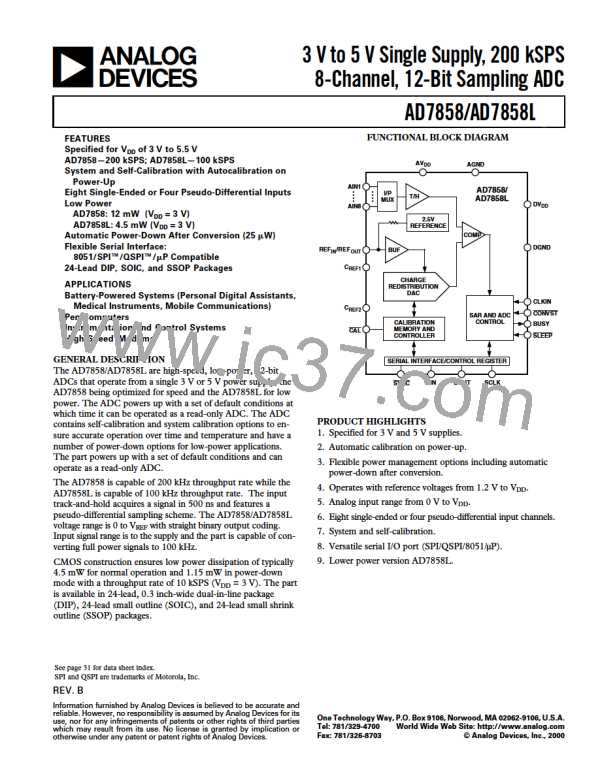AD7858/AD7858L
The recommended value of the external capacitor is 100 nF;
this gives a power-up time of approximately 135 ms before a
calibration is initiated and normal operation should commence.
10
AD7858 (4MHz CLK)
When CREF is fully charged, the power-up time from a hardware
or software power-down reduces to 5 µs. This is because an
internal switch opens to provide a high impedance discharge
path for the reference capacitor during power-down—see Figure
23. An added advantage of the low charge leakage from the
reference capacitor during power-down is that even though the
reference is being powered down between conversions, the
reference capacitor holds the reference voltage to within
0.5 LSBs with throughput rates of 100 samples/second and
over with a full power-down between conversions. A high input
impedance op amp like the AD707 should be used to buffer this
reference capacitor if it is being used externally. Note, if the
AD7858 is left in its power-down state for more than 100 ms,
the charge on CREF will start to leak away and the power-up
time will increase. If this long power-up time is a problem, the
user can use a partial power-down for the last conversion so the
reference remains powered up.
1
AD7858L (1.8MHz CLK)
0.1
0.01
0
5
15
25
THROUGHPUT – kSPS
35
45
10
20
30
40
50
Figure 24. Power vs. Throughput Rate
CALIBRATION SECTION
Calibration Overview
The automatic calibration that is performed on power-up en-
sures that the calibration options covered in this section will not
be required in a significant amount of applications. The user
will not have to initiate a calibration unless the operating condi-
tions change (CLKIN frequency, analog input mode, reference
voltage, temperature, and supply voltages). The AD7858/
AD7858L have a number of calibration features that may be
required in some applications and there are a number of advan-
tages in performing these different types of calibration. First,
the internal errors in the ADC can be reduced significantly to
give superior dc performance, and secondly, system offset and
gain errors can be removed. This allows the user to remove
reference errors (whether it be internal or external reference)
and to make use of the full dynamic range of the AD7858/
AD7858L by adjusting the analog input range of the part for a
specific system.
SWITCH OPENS
DURING POWER-DOWN
AD7858
REF /REF
IN
OUT
ON-CHIP
REFERENCE
EXTERNAL
CAPACITOR
TO OTHER
CIRCUITRY
BUF
Figure 23. On-Chip Reference During Power-Down
POWER VS. THROUGHPUT RATE
The main advantage of a full power-down after a conversion is
that it significantly reduces the power consumption of the part
at lower throughput rates. When using this mode of operation,
the AD7858 is only powered up for the duration of the conver-
sion. If the power-up time of the AD7858 is taken to be 5 µs
and it is assumed that the current during power-up is 4 mA typ,
then power consumption as a function of throughput can easily
be calculated. The AD7858 has a conversion time of 4.6 µs
with a 4 MHz external clock. This means the AD7858 con-
sumes 4 mA typ, (or 12 mW typ VDD = 3 V) for 9.6 µs in every
conversion cycle if the device is powered down at the end of a
conversion. If the throughput rate is 1 kSPS, the cycle time is
1000 µs and the average power dissipated during each cycle is
(9.6/1000) × (12 mW) = 115 µW. The graph, Figure 24, shows
the power consumption of the AD7858 as a function of through-
put. Table VII lists the power consumption for various through-
put rates.
There are two main calibration modes on the AD7858/AD7858L,
self-calibration and system calibration. There are various op-
tions in both self-calibration and system calibration as outlined
previously in Table IV. All the calibration functions can be
initiated by pulsing the CAL pin or by writing to the control
register and setting the STCAL bit to one. The timing diagrams
that follow involve using the CAL pin.
The duration of each of the different types of calibrations is
given in Table VIII for the AD7858 with a 4 MHz master clock.
These calibration times are master clock dependent. Therefore,
the calibrating times for the AD7858L (CLKIN = 1.8 MHz)
will be longer than those quoted in Table VIII.
Table VIII. Calibration Times (AD7858 with 4 MHz CLKIN)
Type of Self- or
Table VII. Power Consumption vs. Throughput
System Calibration
Time
Throughput Rate
Power
Full
Offset + Gain
Offset
Gain
31.25 ms
6.94 ms
3.47 ms
3.47 ms
1 kSPS
10 kSPS
115 µW
1.15 mW
–20–
REV. B

 ADI [ ADI ]
ADI [ ADI ]